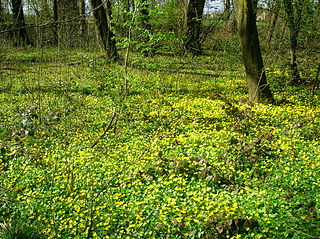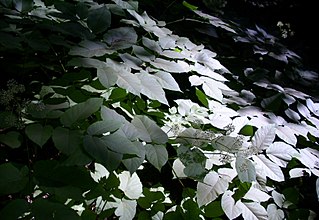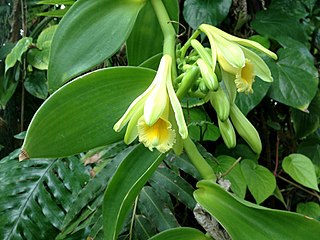
A shade tree is a large tree whose primary role is to provide shade in the surrounding environment due to its spreading canopy and crown, where it may give shelter from sunlight in the heat of the summer for people who seek recreational needs in urban parks and house yards, and thus, also protecting them from the sun's harmful UV rays and sunburns. Therefore, some shade trees may be grown specifically for the comfort of the population due to their convenient shelter.

In forestry and ecology, understory comprises plant life growing beneath the forest canopy without penetrating it to any great extent, but above the forest floor. Only a small percentage of light penetrates the canopy so understory vegetation is generally shade tolerant. The understory typically consists of trees stunted through lack of light, other small trees with low light requirements, saplings, shrubs, vines and undergrowth. Small trees such as holly and dogwood are understory specialists.

Ficus benghalensis, commonly known as the banyan, banyan fig and Indian banyan, is a tree native to the Indian Subcontinent. Specimens in India are among the largest trees in the world by canopy coverage.

Brooklyn Botanic Garden (BBG) is a botanical garden in the borough of Brooklyn in New York City. Founded in 1910 and located in Mount Prospect Park, next to Prospect Park and the Brooklyn Museum, the 52-acre (21 ha) garden includes a number of specialty "gardens within the Garden", plant collections and the Steinhardt Conservatory, which houses the C. V. Starr Bonsai Museum, three climate-themed plant pavilions, a white cast-iron and glass aquatic plant house, and an art gallery. The Garden holds over 14,000 taxa of plants and each year has over 900,000 visitors.

Platanus orientalis, the Old World sycamore, or Oriental plane, is a large, deciduous tree of the Platanaceae family, growing to 30 m (98 ft) or more, and known for its longevity and spreading crown.

The Harry P. Leu Gardens are semi-tropical and tropical gardens in Orlando, Florida, United States. The gardens contain nearly 50 acres (200,000 m2) of landscaped grounds and lakes, with meandering trails shaded by 200-year-old oaks and forests of camellias. They are open to the public. The address is 1920 North Forest Avenue Orlando, FL 32803.
Hidden Lake Gardens colloquially known as Hidden Lake 755 acres (3.06 km2), is a botanical garden and an arboretum operated by Michigan State University situated in the Irish Hills of southeast Michigan. The Gardens are known for their large collection of native and nonnative trees, shrubs and flowers. HLG was given to Michigan State University by Harry Fee in 1945. Today it is visited by nearly 45,000 people annually. Hidden Lake Gardens mission is to "preserve and enhance the natural beauty of the gardens and to display plants for the inspiration and education of the public".

An awning or overhang is a secondary covering attached to the exterior wall of a building. It is typically composed of canvas woven of acrylic, cotton or polyester yarn, or vinyl laminated to polyester fabric that is stretched tightly over a light structure of aluminium, iron or steel, possibly wood or transparent material. The configuration of this structure is something of a truss, space frame or planar frame. Awnings are also often constructed of aluminium understucture with aluminium sheeting. These aluminium awnings are often used when a fabric awning is not a practical application where snow load as well as wind loads may be a factor.

Shade gardens are gardens planted and grown in areas with little or no direct sunlight. Shade gardens may occur naturally or by design under trees, as well as on the side of buildings or fences. This style of garden presents certain challenges, in part because only certain plants are able to grow in shady conditions and otherwise there is direct competition for sunlight. Very few edible plants grow well in shady conditions, so shade gardens are usually ornamental gardens, though growing flowers may also be difficult in shade. Light shade, also known as "dappled sunlight", may support growing herbs or some leaf vegetables, but in addition to lack of light, trees and other large plants which create shade gardens may negatively impact soil fertility.

Rutgers Gardens is the official botanic garden of Rutgers University, located on the outskirts of Cook Campus, at 112 Ryders Lane, North Brunswick, New Jersey. The grounds include 60 acres of designed beds, specialty gardens, tree and shrub collections, lawns, and walking paths, as well as the adjoining 70-acre Frank G. Helyar Woods. A place of learning and beauty, Rutgers Gardens strives to provide a fun, educational, and engaging place for students, faculty, and the community to enjoy the natural world. The gardens are open year-round, without fee, and feature horticultural collections arranged in garden settings. In 2017 it was granted landmark status by the American Society for Horticultural Science.

The JC Raulston Arboretum is a 10-acre (40,000 m2) arboretum and botanical garden administered by North Carolina State University, and located at 4415 Beryl Road, Raleigh, North Carolina. It is open daily to the public without charge.

Inga is a genus of small tropical, tough-leaved, nitrogen-fixing trees and shrubs, subfamily Mimosoideae. Inga's leaves are pinnate, and flowers are generally white. Many of the hundreds of species are used ornamentally.

Laburnum alpinum, the Scotch laburnum, Scottish laburnum or alpine laburnum, is a leguminous, (Leguminosae), deciduous tree.

A stumpery is a garden feature similar to a rockery but made from parts of dead trees. This can take the form of whole stumps, logs, pieces of bark or even worked timber such as railway sleepers or floorboards. The pieces are arranged artistically and plants, typically ferns, mosses and lichens are encouraged to grow around or on them. They provide a feature for the garden and a habitat for several types of wildlife. The first stumpery was built in 1856 at Biddulph Grange and they remained popular in Victorian Britain.

Kew Gardens is a botanic garden in southwest London that houses the "largest and most diverse botanical and mycological collections in the world". Founded in 1840, from the exotic garden at Kew Park in Middlesex, England, its living collections includes some of the 27,000 taxa curated by Royal Botanic Gardens, Kew, while the herbarium, which is one of the largest in the world, has over 8.5 million preserved plant and fungal specimens. The library contains more than 750,000 volumes, and the illustrations collection contains more than 175,000 prints and drawings of plants. It is one of London's top tourist attractions and is a World Heritage Site.

Knaut–Rhuland House is a historic 18th-century house in Lunenburg, Nova Scotia, Canada. It is a designated a National Historic Site of Canada, as well as a Provincially Registered Property under the provincial Heritage Property Act. It is located within the Old Town Lunenburg World Heritage Site. The Knaut–Rhuland House is owned by the Lunenburg Heritage Society, which operates a museum in the house open to the public during the summer.

The gardens of ancient Egypt probably began as simple fruit orchards and vegetable gardens, irrigated with water from the Nile. Gradually as the country became richer, they evolved into pleasure gardens, with flowers, ponds and alleys of fruit and shade trees. Temples, palaces, and private residences had their own gardens, and models of gardens were sometimes placed in tombs so their owners could enjoy them in their afterlife.

Azara microphylla is a species of flowering plant in the family Salicaceae, native to Chile and Argentina. Growing to 10 metres (33 ft), it is a small, upright, evergreen tree or large shrub. It has small, shiny, very dark green leaves and tiny, vanilla-scented flowers in winter. It is the hardiest of the azaras, withstanding temperatures down to −15 °C (5 °F), but in cooler temperate regions requires some protection from cold winds. It also tolerates full shade.

Wetherill Park Nature Reserve, also called Wetherill Park Reserve, is an urban park and a nature reserve situated in the western suburbs of Sydney, New South Wales, Australia. The reserve contains an open woodland and bushland which feature native plants, such as eucalyptus trees, and recreational areas.




























